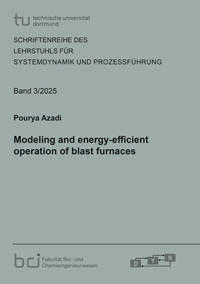
Shop : Details
Shop
Details

February 2025
eBook (PDF)
Pourya Azadi
Modeling and energy-efficient operation of blast furnaces
In the steel industry, the blast furnace is a core piece of equipment along the route from iron ore to steel, with the largest energy consumption and CO2 emissions. The stable, efficient, and economically viable thermal control of blast furnaces is still a challenging task, and fully automatic solutions are not applied industrially. The process exhibits multi-phase and multi-scale physio-chemical phenomena, in the presence of fast and very slow dynamics with latency periods of 6 - 8 hours. Direct online measurements of key inner variables are missing, and unknown disturbances are strongly influencing the process, in particular, the quality of solid raw materials that are fed at the top of the furnace. Partial automation is the state-of-the-art in the operation and control of industrial blast furnaces, and the experience of the operators has a direct impact on the stability and efficiency of the operation. Model-based optimizing control schemes, which can be deployed either in closed-loop or as a guidance system to achieve a smooth, efficient, and reliable operation of blast furnaces, are promising. In this work, a hybrid dynamic model based optimizing control scheme is proposed for the stable, energetically efficient, and economically optimal thermal control of blast furnaces. The underlying optimization problem is formulated as a combined tracking and performance optimizing control problem, where the goal is the tight control of the hot metal silicon content and the slag basicity while simultaneously maximizing the CO-efficiency of the furnace. Simulation results using real operational data of the large-scale blast furnace Schwelgern 2 of thyssenkrupp Steel Europe are presented to demonstrate the potential of the approach for an improved operation of blast furnaces.
Keywords: Blast furnace; Efficiency optimization; Model predictive control (MPC); Hybrid dynamic model; Hot metal silicon content; Slag basicity
Schriftenreihe des Lehrstuhls für Systemdynamik und Prozessführung
Edited by Prof. Dr.-Ing. Sebastian Engell, Dortmund
Volume 2025,3
Other formats
Print version: 978-3-8440-9792-4
DOI 10.2370/9783844098860
You need Adobe Reader, to view these files. Here you will find a little help and information for downloading the PDF files.
Please note that the online documents cannot be printed or edited.
Please also see further information at: Help and Information.
Please also see further information at: Help and Information.
| Document |  | Document | ||
| Type |  | |||
| Costs |  | 44,85 € | ||
| Action |  | Purchase in obligation and download the file | ||
| Document |  | Table of contents | ||
| Type |  | |||
| Costs |  | free | ||
| Action |  | Download the file | ||
User settings for registered online customers (online documents)
You can change your address details here and access documents you have already ordered.
User
Not logged in
Shaker Verlag GmbH
Am Langen Graben 15a
52353 Düren
Germany
Am Langen Graben 15a
52353 Düren
Germany
Mon. - Thurs. 8:00 a.m. to 4:00 p.m.
Fri. 8:00 a.m. to 3:00 p.m.
Fri. 8:00 a.m. to 3:00 p.m.
Contact us. We will be happy to help you.

